Frontiers of Image Reconstruction
Frontiers of Image Reconstruction
Oral
Oral
Acquisition, Reconstruction & Analysis
Thursday, 16 May 2019
| Room 520A-F | 16:00 - 18:00 | Moderators: Li Feng, Julia Velikina |
| 16:00 |
1249. 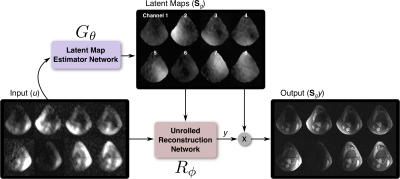 |
Multi-Channel Image Reconstruction with Latent Coils and Adversarial Loss
Joseph Cheng, John Pauly, Shreyas Vasanawala
Model-based accelerated imaging techniques enable high scan time reductions while maintaining high image quality. These techniques rely on the ability to accurately estimate the imaging model. This model can be extended to include information beyond physical limits, such as high-resolution phase information to promote conjugate symmetry or information of voxels without signal for a stronger image prior. Thus, we propose a deep learning approach to estimate the imaging model with latent coil maps. Furthermore, we jointly train this latent map estimator with a deep-learning-based reconstruction using adversarial loss, and we demonstrate the effectiveness of this approach in volumetric knee datasets.
|
| 16:12 |
1250. 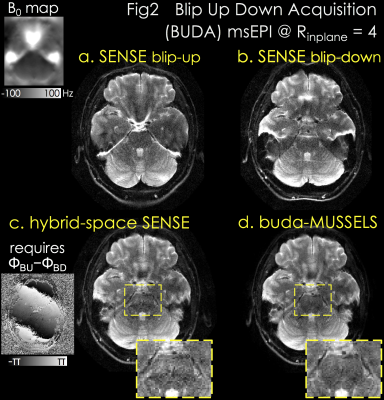 |
Robust high-quality multi-shot EPI with low-rank prior and machine learning
Berkin Bilgic, Congyu Liao, Mary Kate Manhard, Qiyuan Tian, Itthi Chatnuntawech, Siddharth Iyer, Stephen Cauley, Thorsten Feiweier, Shivraman Giri, Yuxin Hu, Susie Huang, Jonathan Polimeni, Lawrence Wald, Kawin Setsompop
We introduce acquisition and reconstruction strategies for robust, high-quality multi-shot EPI (msEPI) without phase navigators. We extend the MUSSELS low-rank constrained parallel imaging technique to perform Virtual Coil (VC) reconstruction, and demonstrate diffusion imaging with sub-millimeter in-plane resolution using 55% partial-Fourier (PF) sampling. We propose Blip Up-Down Acquisition (BUDA) using interleaved blip-up and -down phase encoding, and incorporate B0 forward-modeling into MUSSELS to enable distortion- and navigator-free msEPI. We improve the acquisition efficiency by developing Simultaneous MultiSlice (SMS-)MUSSELS, and combine it with machine learning (ML) to provide Rtotal=16-fold acceleration with 3-shots. Deploying this in a spin-and-gradient-echo (SAGE) scan with signal modeling allows for whole-brain T2 and T2* mapping with high geometric fidelity in 12.5 seconds.
|
| 16:24 |
1251. 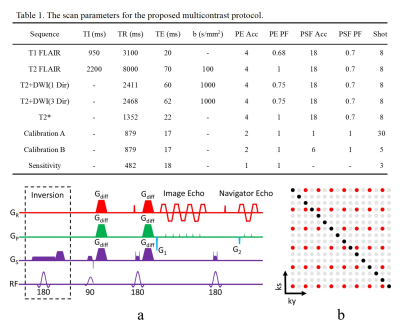 |
Multicontrast Distortion-free MRI Using PSF-EPI
Yishi Wang, Zijing Dong, Zhangxuan Hu, Xuesong Li, Fuyixue Wang, Kawin Setsompop, Ziyi Pan, Chun Yuan, Hua Guo
Fast multimodal exams are required in many situations such as acute ischemic stroke and brain trauma. Recently a multicontrast full brain protocol was proposed based on single shot echo-planar imaging (SS-EPI). However, the SS-EPI images suffer from distortion artifacts. In this work, we provide a speedy multi-contrast distortion-free imaging protocol including T2w, DWI, T2*w, T1 FLAIR and T2 FLAIR based on point spread function encoded echo-planar imaging (PSF-EPI).
|
16:36 |
1252. 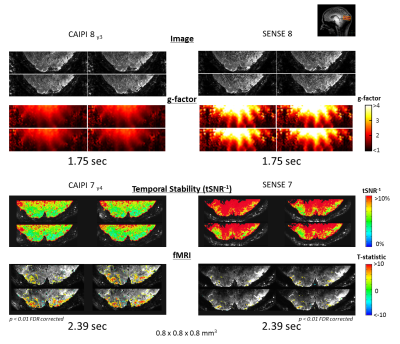 |
Pushing fMRI spatial and temporal resolution further: high density receive arrays combined with shot-selective 2D CAIPIRINHA for 3D EPI scans at 7T
Arjan Hendriks, Federico D’Agata, Luisa Raimondo, Tim Schakel, Liesbeth Geerts, Dennis Klomp, Natalia Petridou
There is an overall drive to high resolution brain MRI with a short scan time. In this study, it was investigated whether 3D EPI fMRI scans acquired with high density receive arrays, can still benefit from a CAIPI sampling pattern, in terms of (temporal) SNR. A 2D CAIPIRINHA acceleration scheme for multi-shot 3D EPI scans was implemented. When combining this implementation with high density receive coil arrays at 7T, it allowed substantial reduction of the scan time for sub-millimeter fMRI scans of the visual cortex.
|
16:48 |
1253. 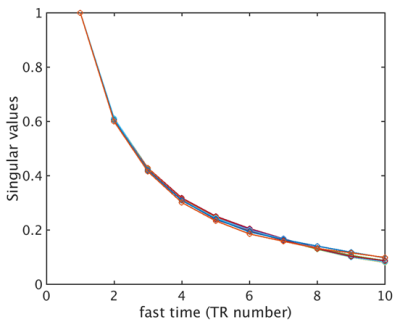 |
Dictionary-Based Oscillating Steady State fMRI Reconstruction
Shouchang Guo, Douglas Noll, Jeffrey Fessler
Oscillating steady state (OSS) imaging is a new fMRI acquisition method that substantially improves SNR by exploiting a large and oscillating signal. However, the oscillation nature of the signal leads to an increased number of acquisitions. To improve the temporal resolution and address the nonlinearity of the OSS signal, we propose a novel dictionary-based regularization method for OSS reconstruction to reconstruct dramatically undersampled (e.g. R = 12) data. The proposed method leads to better image quality than CG-SENSE and does not require any temporal filtering like low-rank methods, therefore the undersampling directly leads to an improved fMRI temporal resolution. The high SNR advantage of OSS is also well preserved.
|
17:00 |
1254. 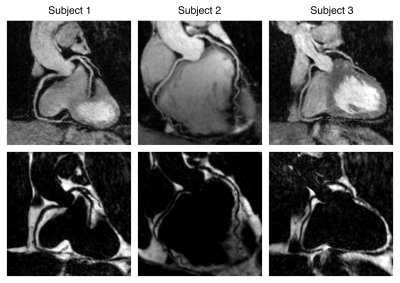 |
Compressed-sensing 1mm-isotropic 3D Whole-Heart Water/Fat Coronary MR Angiography in ~10 minutes
Camila Munoz, Christoph Forman, Radhouene Neji, Karl Kunze, Michaela Schmidt, René Botnar, Claudia Prieto
Prolonged acquisition time and robust fat suppression remain a challenge for coronary MR angiography. Here we present a highly efficient undersampled whole-heart water/fat CMRA acquisition and reconstruction approach, for improved fat suppression at 3Twithin an overall short scan time. The proposed approach is integrated with 2D translational motion correction, to enable 100% respiratory scan efficiency, which in combination with an undersampled acquisition trajectory allows the acquisition of high-resolution water/fat datasets in ~10 minutes. The feasibility of the proposed approach was tested in healthy subjects, and results show improved depiction of the coronary arteries compared to conventional fat suppression.
|
| 17:12 |
1255. 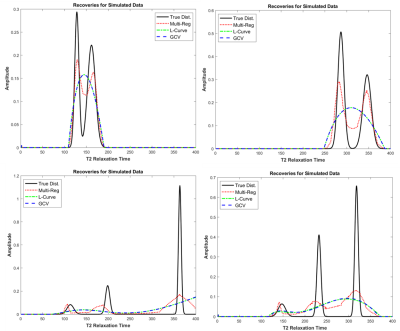 |
Multi-Regularization Reconstruction of One-Dimensional Distributions
Chuan Bi, Miao-Jung Yvonne Ou, Wenshu Qian, You Zhuo, Richard Spencer
Tikhonov regularization and related methods are widely used in recovering relaxation time distributions in magnetic resonance relaxometry. Regularization optimization methods such as the L-curve and generalized cross-validation (GCV) identify a single optimized solution as the best approximation to the underlying distribution. In contrast, we propose a new reconstruction method, Multi-Reg, incorporating a range of regularized solutions. Multi-Reg is based on a dictionary of noise-corrupted regularized reconstructions of distribution basis functions. We demonstrate that Multi-Reg can out-perform L-curve or GCV analyses in simulation analyses of Gaussian distribution components, and with experimental results on mouse spinal cord and human muscle.
|
17:24 |
1256. 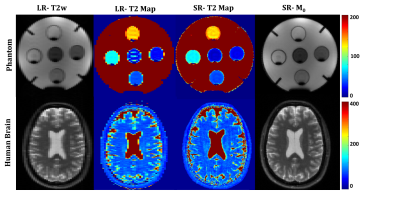 |
High-resolution Isotropic Whole Brain T2 Mapping with Model-based Super-resolution Reconstruction
Wajiha Bano, Gian Franco Piredda, Mike Davies, Ian Marshall, Mohammad Golbabaee, Reto Meuli, Tobias Kober, Jean-Philippe Thiran, Tom Hilbert
We propose a method to reconstruct 1-mm3 isotropic T2 maps based on multiple 2D multi-echo spin-echo (MESE) acquisitions. To compensate for the prolonged scan time due to multiple acquisitions, data were highly (10-fold) undersampled. The data was reconstructed by combining a classical super-resolution approach with an iterative model-based reconstruction. The method was tested on a phantom and four healthy volunteers. T2 values were compared against fully sampled MESE data. The proposed technique allows the assessment of T2 values in brain structures at high isotropic resolution.
|
| 17:36 |
1257. 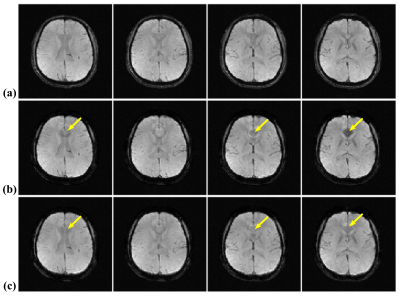 |
Efficient Intravoxel B0 Inhomogeneity Corrected Reconstruction of Multi-Gradient-Echo Images Using A Low-Rank Encoding Operator
Fan Lam, Bradley Sutton
Intravoxel macroscopic B0 field inhomogeneity is common source for image artifacts, and can cause significant errors in quantitative analysis of the imaging data, particularly for gradient-echo-based acquisitions. This work presents a new method for intravoxel B0 inhomogeneity corrected reconstruction. Specifically, we derived a signal model that incorporates intravoxel B0 variations, and introduced a low-rank approximation to the encoding operator. This approximation allows for very efficient computation of the forward model, which can be integrated into any regularized reconstruction formulation. Effective correction for multi-gradient-echo data were demonstrated. We expect the proposed method to be useful for a range of applications involving T2* contrast.
|
| 17:48 |
1258. 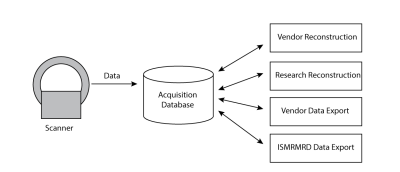 |
Implementation of an MRI Reconstruction Framework with a System-Integrated Acquisition Database
Philip Beatty, Chad Harris, Curtis Weins, David Kennedy, Andrew Curtis, Jeff Stainsby
A reconstruction framework is introduced that adds an acquisition database between the system receive chain and the reconstruction processors. This additional system service opens up a number of dataflow possibilities. The framework is demonstrated on a mid-field superconducting head-only MRI system by simultaneously running three reconstruction programs on the system reconstruction platform and comparing the resulting images.
|
 Back to Program-at-a-Glance |
Back to Program-at-a-Glance |  Back to Top
Back to Top